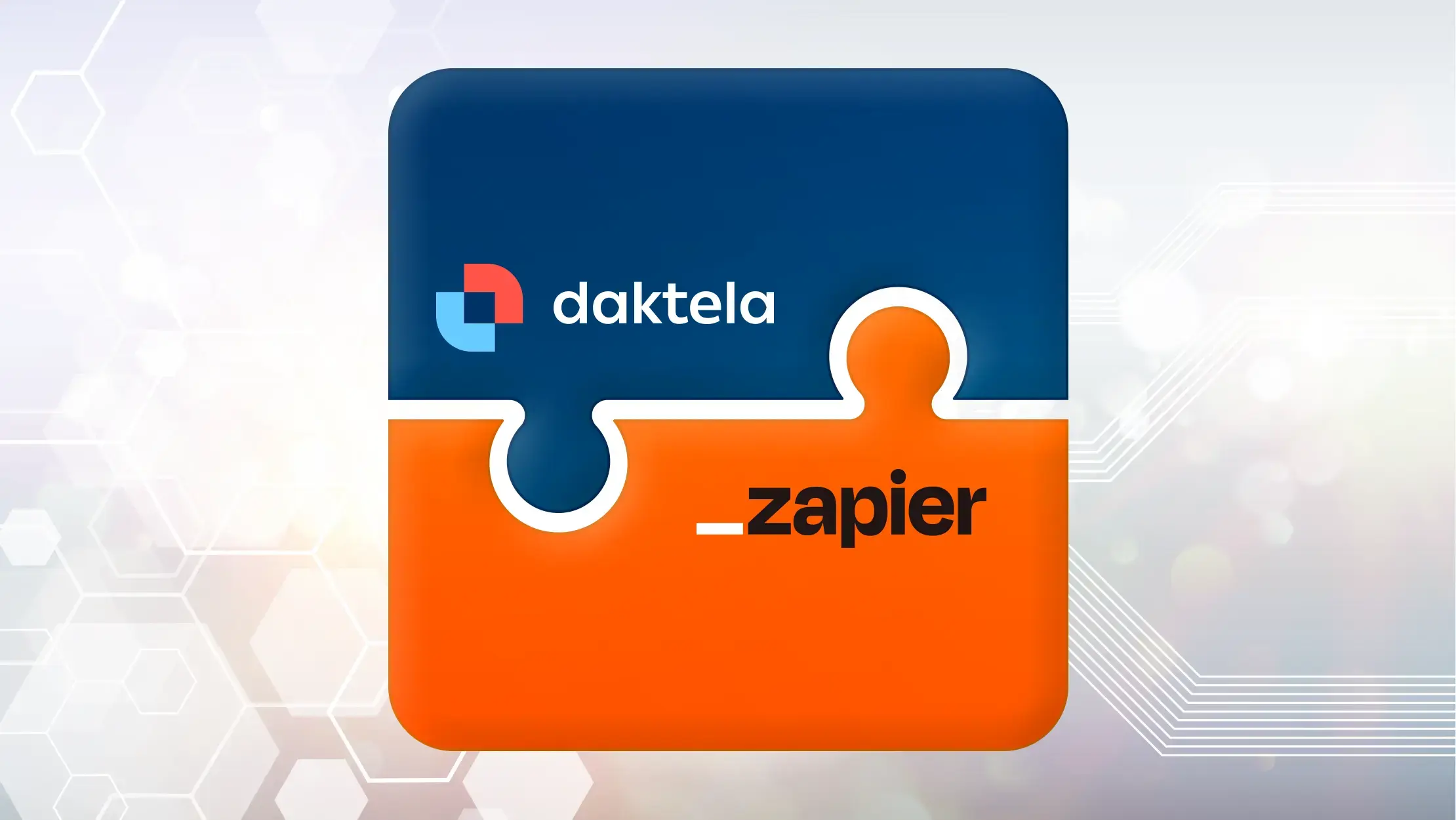If you're new to the world of automation, Zapier might just be the breath of fresh air you've been looking for. It's a remarkably flexible tool that helps sweep away the mundane, repetitive tasks from your daily grind. With its ability to connect to over 7,000 apps and services, Zapier offers businesses a chance to simplify their operations with minimal effort. With just a few clicks, you can link your favourite apps, allowing them to interact with each other. These automated workflows, called Zaps, make sure information is passed between your apps, freeing you from the nitty-gritty of manual input. And the best part? No coding required—Zapier does the heavy lifting, leaving you to focus on what really counts.
At Daktela, we knew this type of integration would be invaluable. Daktela is already designed to help streamline routine tasks, providing a unified omnichannel solution that allows you to deliver smooth, 24/7 customer support. While Daktela has built-in automation features, we thought, why stop there? By integrating Daktela with Zapier, you unlock even greater potential, giving your business the power to automate processes across multiple platforms and systems.
Integration Features
When Daktela meets Zapier, the automation possibilities are endless. Whether you’re setting up a simple connection or something more advanced, Zapier ensures you won’t need to touch a single line of code. You can configure multiple integrations, but let’s dive into a few specific examples of how the integration can make life easier.
First, Zapier works by "polling" Daktela once you've set up a Trigger. This polling can take anywhere between 1 to 15 minutes, depending on your Zapier version, and detects any new events in Daktela. Once a trigger is detected, Zapier takes the reins and carries out the action you've pre-set, all without you lifting a finger.
For instance, when a new ticket is created in Daktela, Zapier can automatically append a predefined comment to the ticket, saving you time and ensuring consistency in messaging. Or, if you receive an email in Gmail, Zapier can instantly create a corresponding ticket in Daktela, making sure no customer query falls through the cracks. Want to keep your team on their toes? Integrate Daktela with Slack, and every time a new ticket is created in Daktela, Zapier can send a timely reminder to the right person in Slack, ensuring follow-ups happen like clockwork.
Get Started: Your First Steps to Automation Bliss
Before I dive into the wonders of automation, I need to set up my Zapier account. Therefore, I head over to the Zapier website and sign up. Once I’m logged in, I navigate to the Apps section, click Add Connection, and type Daktela in the search bar to find the integration. After selecting Daktela, I’m prompted to enter the API URL, which connects my Daktela instance to Zapier. Next, I log in to my Daktela instance, go to Manage → Users → List of Users, and open the details of the user. To be more precise, I’ve to find myself among other users with whom we share the platform. Afterwards I copy the Access Token from the user's detail, then paste it into the designated field on Zapier. And that’s it! My Daktela instance is now connected to Zapier, ready for me to start building powerful Zaps to automate my workflows.
Create a Zap
Alright, here’s where the magic happens—time to create a Zap! Zaps are automated workflows that link your favourite apps and services, making your life much easier. Each Zap has two key ingredients: the Trigger (the event that kicks things off) and the Actions (what happens next).
For example, you could set up a Zap to trigger every time a file is updated in Google Drive, automatically creating a ticket in Daktela. It’s an easy way to save time and avoid the tedious stuff! To get rolling, I pop over to Zapier, click Zaps, and choose Create a New Zap. Now it’s time to pick a Trigger and some Actions, hooking up Daktela with other go-to apps.
Create a Trigger
The Trigger is what gets your Zap going—it’s the first step in making your workflows a bit smarter. Let’s say I want to link Daktela with Slack. Here’s how to set it up:
First up, since I’m connecting Daktela and Slack, I select Daktela as the app where the Trigger happens. After doing so, a sidebar appears on the right, letting me choose the exact event in Daktela that will kick off an action in Slack.
I’ve got options here, but prefer to go with New Ticket Creation. So, when I’ll create a new ticket in Daktela, something exciting will happen in Slack (don’t worry, we’ll figure out exactly what soon enough 😄).
Oh, and don’t forget the polling process—yes, the one I talked about earlier. Once I’ve set up a trigger, Zapier will start polling Daktela to check for any new events that match my criteria. Depending on the specific Zapier plan, this process could take between 1 and 15 minutes. But don’t fret; Zapier will gently nudge you with a visual reminder so you don’t forget.
Next, I select the Daktela instance with myself as a user, that I’ve already linked to Zapier using my access token. This way, everything syncs up nicely, and the right user is connected.
Once the trigger’s set, I’ve got a chance to test it out. To make sure everything’s working, Zapier will try to find a recent ticket created by me in Daktela. So, last but not least, I’ve to create a ticket to figure out what happens next.
I made a ticket for testing, and when I first clicked Find New Records, it didn’t show up right away—my new ticket was mysteriously missing! But on my second try, there it was. Polling delay, perhaps? Anyway, with the trigger tested, I hit Continue with Selected Record, and voilà!
Create an Action
Once I’ve got my trigger set up, the next step is to decide what I want Slack to do when that trigger (a shiny new ticket in Daktela) goes off. This is my Action—the part of the Zap that makes things happen automatically in Slack. Let’s dive in and wrap this up!
So, I’ve picked Slack as the app for the Action. For the specific event, I’ve gone with a reminder—keeping it simple so there’s zero chance of missing a new task in the ticketing system. Of course, I could go fancy and choose Create a private channel or something, but really, do I need that right now? Just want to show that Zapier’s integration options are quite slick.
Before I’m all done, it’s necessary to pick the right Slack account. I’ve opted for my own.Now let’s get into the details. First, I need to select a field and, if I’m feeling extra organised, add some filters. Next, I create the reminder text, set the time I want Slack to remind me in the Remind When field, and—if I’d like to—I can choose others to receive the reminder as well. That last bit is optional, so no pressure. Once that’s set, I hit Continue to test the Action. All’s been filled out correctly, hence, I see the reminder pop up in Slack! When you’ll be about to try yourself, just keep an eye on the time settings to make sure you get it exactly when you want. I went with 1:25 PM—testing it right in the middle of writing this guide!
Almost there! But don’t forget the final, crucial step: Publish your Zap. If you skip this bit, your automation will be stuck in limbo, which is definitely not what you want.
Now your integration is all set up and ready to roll. But wait—do you actually have a Zap set up yet? If not, no worries! Just give us a shout, and we’ll help you get it sorted in no time. Just imagine—one click here, one click there, and your workflow is running smoother than ever. Definitely worth it!







